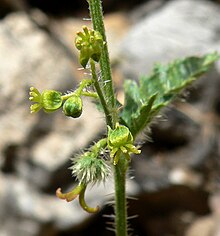Tragia ramosa is a species of flowering plant in the spurge family known by the common names branched noseburn,[2] and desert tragia.
| Tragia ramosa | |
|---|---|

| |
| Scientific classification | |
| Kingdom: | Plantae |
| Clade: | Tracheophytes |
| Clade: | Angiosperms |
| Clade: | Eudicots |
| Clade: | Rosids |
| Order: | Malpighiales |
| Family: | Euphorbiaceae |
| Genus: | Tragia |
| Species: | T. ramosa
|
| Binomial name | |
| Tragia ramosa | |
It is native to the southern Great Plains, South Central, and Southwestern United States and Northern Mexico. It grows in scrub, woodland, and other desert and plateau habitat.
Description
editTragia ramosa is a perennial herb growing mostly erect, measuring 10 to 30 centimeters in maximum height. It is covered in long, rough stinging hairs.[3] The leaves have lance-shaped or oval blades with toothed edges, which are borne on petioles.
The plant is monoecious. Its inflorescence contains a few male flowers and usually one female flower. The flowers lack petals but have green sepals.
The female flower yields a small capsule.
References
edit- ^ NatureServe (2024). "Tragia ramosa". Arlington, Virginia. Retrieved 10 April 2024.
- ^ NRCS. "Tragia ramosa". PLANTS Database. United States Department of Agriculture (USDA). Retrieved 14 December 2015.
- ^ Thurston, E. L. (1976). Morphology, fine structure and ontogeny of the stinging emergence of Tragia ramosa and T. saxicola (Euphorbiaceae). American Journal of Botany 63:6 710-18.
External links
editMedia related to Tragia ramosa at Wikimedia Commons
